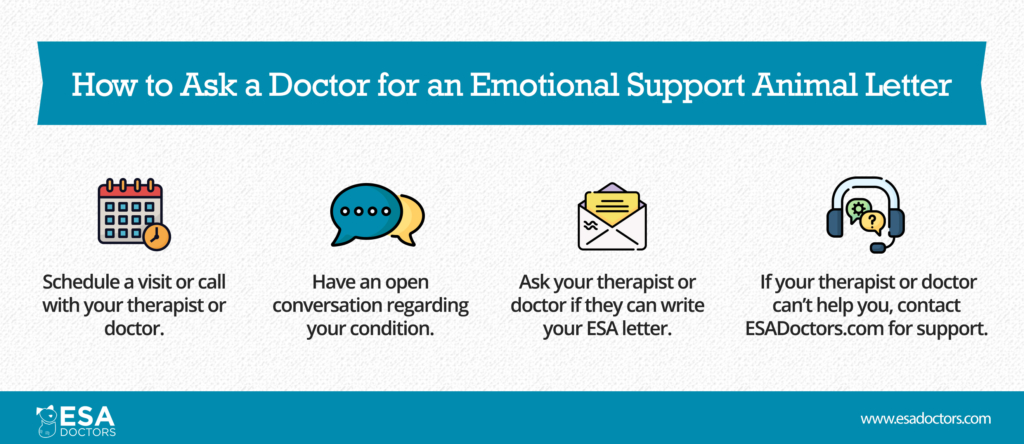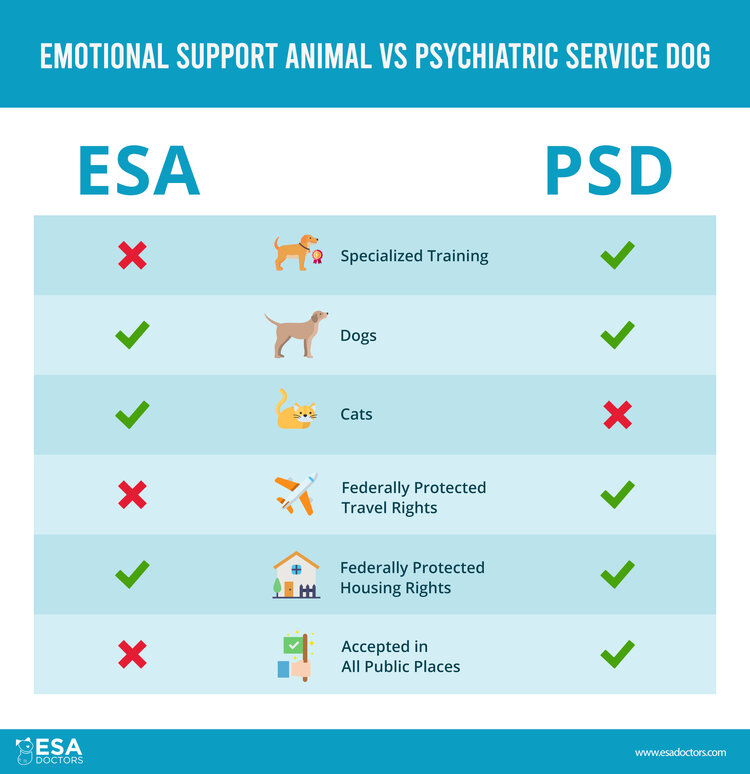Emotional Support Animal Letters versus Psychiatric Service Dog Letters: Which one is right for you?
There are two types of mental health assistance animals protected by federal disability laws: emotional support animals and psychiatric service dogs. There are key differences in how you qualify for one versus the other, and they also have different legal protections when it comes to access rights.
Whether you’re interested in an emotional support animal or a psychiatric service dog, we’ll teach you how to qualify the right way.
If you are ready to work with a licensed healthcare professional for a PSD letter- start here.
In this article, we’ll explain the differences, what to consider when choosing between an ESA or PSD, and how to qualify for each legally. For psychiatric service dogs, here is something that surprises many people: there is no official registration program for service dogs. Registrations are not prerequisites when it comes to qualifying for a psychiatric service dog.
- What is a Service Dog?
- What is an Emotional Support Animal?
- What Rights Do Service Dogs Have?
- What Rights Do Emotional Support Animals Have?
- What Makes a Service Dog Legitimate?
- What Makes an ESA Legitimate?
- Should you get an ESA Letter or a PSD Letter?
What is a Service Dog?
A service dog is a type of assistance animal that is individually trained to perform tasks relating to a disability. The disability can be physical in nature (for example, limited mobility or sight impairment), or it can be psychological (depression, severe anxiety, learning disabilities, etc.). If the service dog helps with a mental or emotional health issue, it is referred to as a psychiatric service dog.
The main difference between a psychiatric service dog and an emotional support animal is that PSDs must be trained to perform a task relating to the disability. For instance, the dog can be trained to provide comfort through tactile stimulation, pawing, or pressure therapy during moments of crisis. A PSD may retrieve medication or remind their handlers of important daily routines. There are countless tasks that PSDs are trained to perform for the benefit of their handlers. These tasks are individually tailored to the specific needs of the handler.
Another important distinction between PSDs and ESAs is that a psychiatric service animal under ADA guidelines can only be a dog. On the other hand, emotional support animals can be dogs, cats, birds, rodents, fish, gerbils, and other small, domesticated household pets.
Any dog that is a potential candidate to be a PSD must have the appropriate trainability, temperament, and abilities to perform disability-related tasks and accompany its handler in a wide variety of public settings.

What is an Emotional Support Animal?
Emotional support animals assist with conditions that are similar to those that afflict psychiatric service dog handlers. For example, ESAs assist owners that have the following conditions:
- Anxiety
- Depression
- Mood disorder
- Bipolar
- Panic attacks
- Fears and phobias
- PTSD
The primary difference between ESAs and PSDs lies in how an ESA provides assistance.
An ESA is not required to have individualized special training to assist with the owner’s condition. Emotional support animals provide comfort and support simply by being in the owner’s presence. Their companionship is what alleviates symptoms of the owner’s mental or emotional disability.
As previously mentioned, an emotional support animals (ESA) can be a wide variety of animals and are not just limited to dogs.

What Rights Do Service Dogs Have?
PSDs are protected under various federal and state laws, including the Americans with Disabilities Act (ADA), the Fair Housing Act (FHA), and the Air Carrier Access Act (ACAA).
Psychiatric service dogs are allowed to board the cabin of airplanes with their handlers free of charge. This right is protected by regulations issued by the U.S. Department of Transportation that were most recently updated in early 2021.
Service dogs also have rights when it comes to housing under guidelines issued by the U.S. Department of Housing. Housing providers must provide reasonable accommodation for psychiatric service dog owners. That means a PSD owner must be allowed to live with their service dog, without any fees or deposits, even in buildings that ban pets. Psychiatric service dogs are also not subject to building restrictions based on breed or size of the animal.
Lastly, PSDs have public access rights that allow them to accompany their owners in places that are generally open to the public. That includes retail stores, restaurants, grocery markets, libraries, performance venues, public beaches, and parks that prohibit pets and school campuses.
PSDs are considered essential to the health and wellbeing of individuals with mental or emotional disabilities, and federal disability laws demand that public establishments accommodate them. However, this is not absolute: the PSD must be properly trained and well-behaved in the public environment, and its presence cannot create a safety or health issue to others on the premises.
What Rights Do Emotional Support Animals Have?
Owners of emotional support animals have legal protection under federal and state fair housing laws. Housing providers such as HOAs, co-ops, and rental property owners must reasonably accommodate tenants with an emotional support animal. That means that if you own an ESA, your housing provider must allow your animal companion to live in your residence even if the building strictly prohibits all animals.
ESAs are also not subject to breed and weight restrictions that a building may apply to normal pets. Having an ESA can also save you money because housing providers are not allowed to charge any fees or deposits for emotional support animals.
If you rely on an emotional support animal to maintain your mental health, housing laws give you a right to live with your ESA free from discrimination or charge.

What Makes a Service Dog Legitimate?
For a psychiatric service dog to be legitimate, it must be individually trained to perform a task or multiple tasks relating to the handler’s disability. A service dog in training is not considered an actual service dog until it has completed its training.
Contrary to popular myth, there is no need to certify or register a service dog, and you do not need to obtain an ID card, special harness, or vest. These services and accessories are all completely optional. To qualify for a psychiatric service dog, you must have an ADA mental health disability and a fully task-trained dog capable of handling public settings.
In order to verify that your dog is a PSD, third parties can ask you two verification questions:
- Is the dog a service animal required because of a disability?
- What work or task has the dog been trained to perform?
It’s important to note that under ADA guidelines, third parties at a venue cannot ask for documentation, demand the dog perform the task it has been trained for, or inquire about the specifics of the handler’s disability. Psychiatric service dog owners have a right to privacy and dignity regarding their health condition and needs for a PSD.
PSD owners should also note that there is a special requirement when traveling by air with a PSD. To board flights with a PSD, the handler must submit the DOT’s Service Animal Air Transportation form to the airline before boarding the flight. The form requires the handler to make various self-certifications regarding their eligibility and their dog’s qualification as a psychiatric service dog.
If you’re interested in owning a psychiatric service dog, the first step is to understand whether you have a qualifying condition under the ADA. The licensed healthcare professionals that work with ESA Doctors can evaluate your mental and emotional health. If you qualify, they can issue a signed Psychiatric Service Dog (PSD) Letter that states whether you have a mental health disability for purposes of the ADA.
A PSD letter provides peace of mind and documentation of your mental health condition and can be the first step on the path towards owning a legitimate psychiatric service dog.
Want to know if you qualify for a Psychiatric Service Dog? Click Here to get your PSD Letter.
What Makes an ESA Legitimate?
To qualify for an emotional support animal, you need a letter from a mental health or other licensed healthcare professional. The letter should be signed and dated on the provider’s letterhead with their license number. Once you have an ESA letter, you can submit it to your landlord, co-op, HOA, or property manager and request accommodation of your emotional support animal.
Federal and state laws require housing providers to reasonably accommodate emotional support owners that present a valid ESA letter unless they are subject to a valid exemption (such as if the ESA has demonstrated it would pose a safety risk to other tenants or if the building is owner-occupied with no more than four units).
If you’re interested in qualifying for an emotional support animal, there is no better place to turn than ESA Doctors. ESA Doctors only works with state-licensed healthcare professionals that are knowledgeable about emotional support animal qualification.
The process to see if you qualify for an ESA through ESA Doctors is convenient and 100% digital; there is no need to leave your home to make any office visits. There is no need to register or certify an ESA. The only way to enjoy the legal protections given to emotional support animal owners under federal and state housing laws is to present your landlord with an ESA letter.
How Do I Get an ESA Letter from ESA Doctors? Click Here
Should you get an ESA Letter or a PSD Letter?
For many assistance animal owners, just having their animal friend around is enough to help with their mental or emotional distress symptoms. For these owners, qualifying for an emotional support animal letter is enough.
However, if your mental health disability requires your dog to perform trained tasks, a PSD letter may be more appropriate. Another consideration is whether you need your assistance animal by your side when you fly. Emotional support animals are treated as normal pets on flights, so they may be subject to hefty fees or be relegated to cargo. PSDs are allowed to board flights with their owners free of charge, which can be a major benefit to owners that require a service dog during travel.
It is not an easy process to train a dog to perform disability-related tasks and prepare them for the rigors of being in public settings. Not all dogs are suited to the job either; it requires a certain temperament and receptivity to training. It is possible to train an emotional support animal to eventually become a psychiatric service dog with the appropriate conditions and dedication. No matter how difficult the training process, however, psychiatric service dog owners will tell you that it’s completely worth it when it comes to their mental health and general wellbeing.
Interested in qualifying for an ESA or PSD letter? See why both emotional support animal and psychiatric service dog owners consistently leave us stellar reviews and trust us year after year when it comes to qualifying for an ESA or PSD letter from a licensed healthcare professional. To get started today, click on the links below.










Can you register a dog and a cat for a service animal so you can keeps them both as emptional help
You do not need to register a service animal (and service animals can only be dogs). If you only need your animals for emotional assistance, you are likely seeking an emotional support animal. Both dogs and cats are eligible to be emotional support animals. Please see this link for more information on the ESA process: https://esadoctors.com/how-to-get-emotional-support-animal/
If my docter had written a letter out to my landlord.. am i required to give them my dogs license number
ESAs are not required to have a special license number. However, your jurisdiction may require a license number for all dogs, not just ESAs. In that case, your ESA would need that general dog license.
Im curious, do you even need to do an online registration for an ESA or just a doctor letter to determine your pets status.
You do not need to register an ESA. A letter from a licensed healthcare professional is the only document that will qualify you to have an ESA.
Do I need to show my dogs certificate, when i already have his ID card. Do i need both to show proof hes my ESA.
Certificates, IDs and registrations are not effective ways to qualify an emotional support animal. The only way to qualify an animal companion as an ESA is to obtain a recommendation letter from a licensed health care professional. You would then present this letter to your landlord or the airline and request accommodation of your ESA.
my grand daughter is 16 and has a service dog.she has anxiety and depression and is on meds.she has panic attacks,has difficulty breathy and passing out due to anxiety.Who name would the lic and documents be in/Mine or hers.she is the one who needs it.
Your daughter would need to be assessed by a licensed mental health professional. The LMHP would determine whether your daughter qualifies for an ESA letter.
Hello,
My primary care physician is a Certified Psychiatric Nurse Practitioner Healthcare Provider. Can he write my letter for me? He has a medical license to prescribe my medications as his patient.
That should be okay, Fair Housing rules allow for nurse practitioners to write ESA letters.
Can a community request medical records from your doctor to approve a service animal or emotional support animal?
NO! Your private medical records are private and privileged. The Fair Housing Act does not require you to share your medical records or medical history in order to have reasonable accommodations for you and your ESA.
Can my family doctor write a letter for ESA animal? She is treating me for depression and anxiety
Yes, an ESA letter can come from a licensed mental health professional, which includes psychologists, psychiatrists, registered nurses, social workers and doctors.
Does the ESA license override the SPCA?
Can you please elaborate on your question?
Airlines can request “documentation” of your service animal, what kind of documentation is this? For SERVICE not ESA
Some airlines will require additional documentation that they provide. You can find out if your airline requires additional documentation by contacting their disability department.
For an emotional therapy dog certificate , plus registration, where would I send this letter to? Plus would I be able to take her on public transportation
Therapy dogs and emotional support dogs are not the same. You can send your ESA letter to your landlord to live and airline to travel. Both animals do not have public access rights on public transportation.
My daughters have adopted our dog in the middle of a DV divorce. Would a letter from their pediatrician be valid if he worked with them through depression and anxiety. We are looking to register for housing purposes.